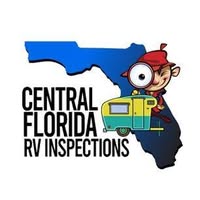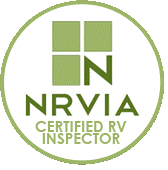Roof Condition
Sealant and Joint Condition
Vents, air conditioner’s, antenna, other roof mounted items
Appearance and function condition of sidewalls, entrance doors, windows and cargo access
Damage, discoloration and delamination of sidewall and end cap components.
Rate the slide out roof condition
Condition of seals, sweeps and gaskets for possible damage
Condition of awning frames and latching mechanisms
Condition of 7 pin connector
Activate and evaluate the operation of the DOT lights
Circuit breaker box wiring, breakers and grounding connections
Test output operation of the 120 VAC to 12 VDC converter for charging of the deep cycle batteries (if equipped)
Note model number and run hours
Check oil level
Start and operate the onboard generator
strongly recommend performing fluid analysis
Visually inspect coolant reservoir, radiator and hoses.
strongly recommend performing fluid analysis
Wiring , electrical connections and fuses/circuit breakers
Note location of the battery stack
Condition, age and match sizing of the battery stack
Wiring, fuse panel and fuses of the 12 Volt DC electrical system
Onboard fresh water tank and pressure pump system operates and maintains pressure.
Fresh water fixtures inside and outside of RV
Test both waste (gray and black) plumbing systems for leaks under the sinks, shower, around toilet & discharge lines
Verify Drain cap is in place and will hold waste water.
LP gas timed leak test at cook top burner
Ground Fault Circuit Interrupter (GFCI) circuits
Wall receptacles and ground fault
Hot skin test on exterior
Emergency exit windows
Fire Extinguisher
Smoke/Fire Detector
Carbon Monoxide Detector (if applicable)
LP Gas Detector
Rubber grommet around LP gas line of water heater (if equipped)
Inspect hoses and pressure regulators for damage and age deterioration
Verify plastic cover has been installed over regulator.
Verify single state regulator is installed on split tank systems.
Document manufactured dates of DOT cylinders
Tank sizes that have been installed
Exterior of cylinder to check for rust and other damage
Check tank for rust or physical damage (if accessible)
Document manufactured date
Identify type of refrigerator
Operate on all heat sources – 120 volt AC, LP gas, and 12 volt DC for three way refrigerators
Collect serial and model number, verify with manufacturer if recall notice has been issued and completed for unit
Test interior temperature of upper and lower refrigerator compartments and ice maker (if installed)
Refrigerator must be operational for a minimum of 12 hours prior to inspection commences.
Identify brand, model and type of water heater
Burner assembly and gas exhaust system, check for blockages and insect infestation
Verify operation on all heat sources – LP gas and 120 volt AC if equipped with heating element
Identify brand, model and type (if accessible)
Inspect air intake and exhaust assembles for blockages and insect infestation
Warm air discharge out vents and return air flow of unit.
Condition of cook top and or stove
Ignition and operation of all top burners and the oven flame (if equipped)
Condition of metal grill top and rubber grommets of top burner area
Identify type of cooling unit/heat pump
Cooling efficiency test (Delta T) on each unit
Note model (if accessible)
Identify brand, model, type and output wattage of unit
Operate unit for 60 seconds utilizing cup of water and then list water temperature
Identify brand and type of unit.
Ceilings, walls, interior doors and flooring for signs of water intrusion, surface damage and/or staining
Operate windows, doors and note any deficiencies or missing components.
Interior, exterior and décor lighting-12 VDC and 120VAC
Cabinet doors, drawers and pullout operation
Visually inspect all counter tops and flat surfaces areas of kitchen, living room, bathroom, bedroom and storage areas for damage and or scratches.
Condition of dinette table/booth, chairs, recliners and sofa
Note furniture fabric tears, discoloration and signs of excess wear
Note signs of mattress damage or staining.
TV and Stereo equipment
DVD/Disc players and radios
Raise and lower roof mounted antenna (if equipped)
Glass panels, curtains and soap dish areas
Rate seals around frame work and doors for water leaks
Extend and retract leveling system
Hydraulic leaks or mechanical issues
Type and number of axles
Check frame, axles, springs, rims and other components for rust, oil stains and visible damage. Note: inspector is not allowed under the RV per insurance company rules.
Document tire age and weight capacity
Tire tread condition
Vehicle Identification Number (VIN)
License Plate Information
Inspection Sticker Information – if applicable
RVIA Inspection seal number
Gross Vehicle Weight Rating
Manufacture Date

